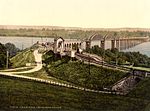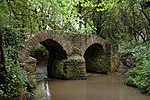Sharpness
Populated places on the River SevernPorts and harbours of GloucestershireStroud DistrictUse British English from March 2015Villages in Gloucestershire

Sharpness ( sharp-NESS) is an English port in Gloucestershire, one of the most inland in Britain, and eighth largest in the South West England region. It is on the River Severn at grid reference SO669027, at a point where the tidal range, though less than at Avonmouth downstream (14 metres (46 ft) typical spring tide), is still large (10 metres (33 ft) typical spring). There is a small community of approximately 100 residents directly adjacent to the port, in addition to the subvillage of Newtown approximately 0.5 miles to the south-east. Four miles to the south lies the small town of Berkeley.
Excerpt from the Wikipedia article Sharpness (License: CC BY-SA 3.0, Authors, Images).Sharpness
Dock Road,
Geographical coordinates (GPS) Address Nearby Places Show on map
Geographical coordinates (GPS)
| Latitude | Longitude |
|---|---|
| N 51.723 ° | E -2.478 ° |
Address
TS Vindicatrix
Dock Road
GL13 9UA
England, United Kingdom
Open on Google Maps







